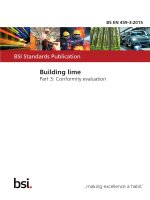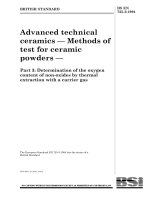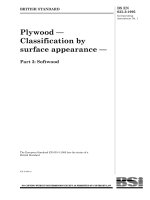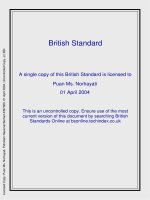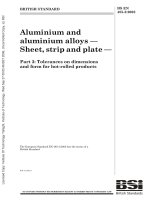Bsi bs en 61300 3 14 2014
Bạn đang xem bản rút gọn của tài liệu. Xem và tải ngay bản đầy đủ của tài liệu tại đây (1.67 MB, 16 trang )
BS EN 61300-3-14:2014
BSI Standards Publication
Fibre optic interconnecting
devices and passive
components — Basic
test and measurement
procedures
Part 3-14: Examinations and
measurements — Error and repeatability
of the attenuation settings of a
variable optical attenuator
BRITISH STANDARD
BS EN 61300-3-14:2014
National foreword
This British Standard is the UK implementation of EN 61300-3-14:2014. It is
identical to IEC 61300-3-14:2014. It supersedes BS EN 61300-3-14:2007
which is withdrawn.
The UK participation in its preparation was entrusted by Technical
Committee GEL/86, Fibre optics, to Subcommittee GEL/86/2, Fibre optic
interconnecting devices and passive components.
A list of organizations represented on this committee can be obtained on
request to its secretary.
This publication does not purport to include all the necessary provisions of
a contract. Users are responsible for its correct application.
© The British Standards Institution 2014.
Published by BSI Standards Limited 2014
ISBN 978 0 580 84233 7
ICS 33.180.20
Compliance with a British Standard cannot confer immunity from
legal obligations.
This British Standard was published under the authority of the
Standards Policy and Strategy Committee on 31 December 2014.
Amendments/corrigenda issued since publication
Date
Text affected
EUROPEAN STANDARD
EN 61300-3-14
NORME EUROPÉENNE
EUROPÄISCHE NORM
November 2014
ICS 33.180.20
Supersedes EN 61300-3-14:2007
English Version
Fibre optic interconnecting devices and passive components Basic test and measurement procedures Part 3-14: Examinations and measurements - Error and
repeatability of the attenuation settings of a variable optical
attenuator
(IEC 61300-3-14:2014)
Dispositifs d'interconnexion et composants passifs à fibres
optiques - Procédures fondamentales d'essais et de
mesures - Partie 3-14: Examens et mesures - Erreur et
répétabilité des positions d'affaiblissement d'un affaiblisseur
optique variable
(CEI 61300-3-14:2014)
Lichtwellenleiter - Verbindungselemente und passive
Bauteile - Grundlegende Prüf- und Messverfahren Teil 3-14: Untersuchungen und Messungen - Abweichung
und Reproduzierbarkeit der Einstellung eines einstellbaren
optischen Dämpfungsgliedes
(IEC 61300-3-14:2014)
This European Standard was approved by CENELEC on 2014-11-14. CENELEC members are bound to comply with the CEN/CENELEC
Internal Regulations which stipulate the conditions for giving this European Standard the status of a national standard without any alteration.
Up-to-date lists and bibliographical references concerning such national standards may be obtained on application to the CEN-CENELEC
Management Centre or to any CENELEC member.
This European Standard exists in three official versions (English, French, German). A version in any other language made by translation
under the responsibility of a CENELEC member into its own language and notified to the CEN-CENELEC Management Centre has the
same status as the official versions.
CENELEC members are the national electrotechnical committees of Austria, Belgium, Bulgaria, Croatia, Cyprus, the Czech Republic,
Denmark, Estonia, Finland, Former Yugoslav Republic of Macedonia, France, Germany, Greece, Hungary, Iceland, Ireland, Italy, Latvia,
Lithuania, Luxembourg, Malta, the Netherlands, Norway, Poland, Portugal, Romania, Slovakia, Slovenia, Spain, Sweden, Switzerland,
Turkey and the United Kingdom.
European Committee for Electrotechnical Standardization
Comité Européen de Normalisation Electrotechnique
Europäisches Komitee für Elektrotechnische Normung
CEN-CENELEC Management Centre: Avenue Marnix 17, B-1000 Brussels
© 2014 CENELEC All rights of exploitation in any form and by any means reserved worldwide for CENELEC Members.
Ref. No. EN 61300-3-14:2014 E
BS EN 61300-3-14:2014
EN 61300-3-14:2014
Foreword
The text of document 86B/3816/FDIS, future edition 3 of IEC 61300-3-14, prepared by SC 86B “Fibre
optic interconnecting devices and passive components” of IEC/TC 86 “Fibre optics" was submitted to
the IEC-CENELEC parallel vote and approved by CENELEC as EN 61300-3-14:2014.
The following dates are fixed:
•
latest date by which the document has to be
implemented at national level by
publication of an identical national
standard or by endorsement
(dop)
2015-08-14
•
latest date by which the national
standards conflicting with the
document have to be withdrawn
(dow)
2015-11-14
This document supersedes EN 61300-3-14:2007.
Attention is drawn to the possibility that some of the elements of this document may be the subject of
patent rights. CENELEC [and/or CEN] shall not be held responsible for identifying any or all such
patent rights.
Endorsement notice
The text of the International Standard IEC 61300-3-14:2014 was approved by CENELEC as a
European Standard without any modification.
BS EN 61300-3-14:2014
EN 61300-3-14:2014
Annex ZA
(normative)
Normative references to international publications
with their corresponding European publications
The following documents, in whole or in part, are normatively referenced in this document and are
indispensable for its application. For dated references, only the edition cited applies. For undated
references, the latest edition of the referenced document (including any amendments) applies.
NOTE 1 When an International Publication has been modified by common modifications, indicated by (mod), the relevant
EN/HD applies.
NOTE 2 Up-to-date information on the latest versions of the European Standards listed in this annex is available here:
www.cenelec.eu
Publication
Year
Title
EN/HD
Year
IEC 61300-1
-
Fibre optic interconnecting devices and
passive components - Basic test and
measurement procedures Part 1: General and guidance
EN 61300-1
-
IEC 61300-3-4
-
Fibre optic interconnecting devices and
EN 61300-3-4
passive components - Basic test and
measurement procedures Part 3-4: Examinations and measurements
- Attenuation
-
– 2–
BS EN 61300-3-14:2014
IEC 61300-3-14:2014 © IEC:2014
CONTENTS
1
Scope .............................................................................................................................. 5
2
Normative references ...................................................................................................... 5
3
General description ......................................................................................................... 5
4
Apparatus ........................................................................................................................ 7
4.1
Light source (S) and launch conditions ................................................................... 7
4.2
Detector (D) ............................................................................................................ 7
4.3
Reference fibre (RF) ............................................................................................... 7
4.4
Temporary joint (TJ) ............................................................................................... 7
5
Measurement procedure .................................................................................................. 8
5.1
Measurement set-up ............................................................................................... 8
5.2
Measurement procedure ......................................................................................... 8
6
Calculation ...................................................................................................................... 8
6.1
Attenuation error for VOAs with absolute calibration ............................................... 8
6.2
Attenuation error for VOAs with relative calibration ................................................. 9
6.3
Maximum deviation of attenuation from setting for all attenuation levels.................. 9
6.4
Repeatability of attenuation .................................................................................... 9
7
Measurement report ........................................................................................................ 9
8
Details to be specified ................................................................................................... 10
8.1
8.2
8.3
8.4
8.5
8.6
8.7
8.8
8.9
Annex A
General ................................................................................................................. 10
Light source and launch condition ......................................................................... 10
Detector ................................................................................................................ 10
Reference fibre ..................................................................................................... 10
Temporary joint ..................................................................................................... 10
DUT ...................................................................................................................... 10
Measurement procedure ....................................................................................... 10
Measurement uncertainty ...................................................................................... 10
Others................................................................................................................... 10
(informative) Example of a sample measurment record .......................................... 11
Annex B (informative) Measurement method of hysteresis characteristics ............................ 12
B.1
B.2
B.3
General ................................................................................................................. 12
Measurement procedure ....................................................................................... 12
Calculation ............................................................................................................ 12
Figure 1 – Measured versus nominal attenuation .................................................................... 6
Figure 2 – Measurement set-up .............................................................................................. 8
Table A.1 – Device performance specifications versus actual performance ........................... 11
BS EN 61300-3-14:2014
IEC 61300-3-14:2014 © IEC:2014
–5–
FIBRE OPTIC INTERCONNECTING
DEVICES AND PASSIVE COMPONENTS –
BASIC TEST AND MEASUREMENT PROCEDURES –
Part 3-14: Examinations and measurements –
Error and repeatability of the attenuation settings
of a variable optical attenuator
1
Scope
This part of IEC 61300 provides a method to measure the error and repeatability of the
attenuation value settings of a variable optical attenuator (VOA). There are two control
technologies for VOAs, manually controlled and electrically controlled. This standard covers
both control technologies of VOAs and also covers both single-mode and multimode fibre
VOAs.
2
Normative references
The following documents, in whole or in part, are normatively referenced in this document and
are indispensable for its application. For dated references, only the edition cited applies. For
undated references, the latest edition of the referenced document (including any
amendments) applies.
IEC 61300-1, Fibre optic interconnecting devices and passive components – Basic test and
measurement procedures – Part 1: General and guidance
IEC 61300-3-4, Fibre optic interconnecting devices and passive components – Basic test and
measurement procedures – Part 3-4:Examinations and measurements − Attenuation
3
General description
A variable optical attenuator is adjusted sequentially through a series of nominal attenuation
settings prescribed in the relevant specification. For an electrically controlled VOA, the
attenuation is set by applying electrical voltage or current to the device.
There are two categories of VOAs:
–
those that can be adjusted to nominal attenuation levels;
–
those that have no information on the nominal attenuation levels.
Some manually controlled VOAs have a scaled dial to indicate the nominal attenuation levels.
Some electrically controlled VOAs have a table (or equation) indicating the applied voltage (or
current) corresponding to nominal attenuation levels. This measurement method of
attenuation error and repeatability can only be applied to VOAs which can be adjusted to
nominal attenuation levels.
In this type of measurement, the attenuation value is measured at each setting. This
sequence of measurements is repeated a number of times as prescribed in the relevant
specification. The error of the attenuator at each setting is then given by the difference
between the mean of the measured values and the nominal value. The repeatability at each
setting is given by a value of plus and minus three times the standard deviation of the
measurements.
BS EN 61300-3-14:2014
IEC 61300-3-14:2014 © IEC:2014
– 6–
Generally the nominal attenuation levels are provided in different two ways, i.e. absolute or
relative attenuation calibration levels. Figure 1a characterizes an attenuator which is
calibrated to read the actual or measured attenuation. Figure 1b characterizes an attenuator
for which the manufacturer provides the calibration results relative to a zero-point setting.
When the attenuator is adjusted to read zero, the actual or measured attenuation will be some
value greater than zero.
Ideal curve
Measured attenuation (ai) dB
30
ai = Ai
(A5, a5)
ai ± 3σi
(A4, a4)
20
(A3, a3)
Error: δai = ai – Ai
3σ-Repeatability: ∆ai = ± 3σi
10
(A2, a2)
(A1, a1)
0
0
10
20
Nominal attenuation
setting (Ai) dB
30
IEC
Figure 1a – Absolute calibration of attenuation
Ideal curve
Measured attenuation (ai) dB
ai = Ai + a1
30
(A5, a5)
(A4, a4)
ai ± 3σi
20
(A3, a3)
Error: δai = ai – a1 – Ai
3σ-Repeatability: ∆ai = ± 3σi
10
(A2, a2)
a1 = zero-point attenuation (mean value)
(A1, a1)
0
0
10
20
Nominal attenuation
setting (Ai) dB
30
IEC
Figure 1b − Calibration relative to zero-point setting
Figure 1 – Measured versus nominal attenuation
BS EN 61300-3-14:2014
IEC 61300-3-14:2014 © IEC:2014
4
4.1
–7–
Apparatus
Light source (S) and launch conditions
The output power of the light source shall be sufficiently high to permit a sufficiently large
measurement dynamic range with the optical detector used. The output power stability shall
be less than or equal to 0,05 dB over one hour. The dynamic range of the source/detector
combination shall be at least 10 dB greater than the absolute value of the maximum
attenuation value to be measured. However the output power into the fibre shall not exceed
the maximum operating input power rating of the VOA to be tested.
The wavelength and spectral width of the light source shall correspond to
wavelength range and calibration settings of the VOA to be measured.
the operating
For the measurement of single-mode VOAs, polarization dependent loss (PDL) may influence
the error and repeatability of attenuation values. Unless otherwise specified, random
polarization states shall be used or the PDL shall also be characterized.
Other requirements of the light source and launch conditions shall be in accordance with
IEC 61300-3-4. An excitation unit shall be used to satisfy the launch condition defined in
IEC 61300-1, if necessary. Moreover cladding modes shall be stripped as typically achieved
by the fibre coating, so that they do not affect the measurement.
4.2
Detector (D)
A high dynamic range optical power meter should be used for the detector. Its wavelength
range shall be wider than the operating wavelength range of the VOA to be measured. In
order to make measurements with low uncertainty, the linearity of the optical power meter is
most important for the error and repeatability of VOA measurements. The minimum resolution
of the detector shall be ≤0,01 dB.
Other requirements of detector shall be in accordance with IEC 61300-3-4.
4.3
Reference fibre (RF)
In order to measure the output power of the light source, a reference fibre is used. The
reference fibre shall be of the same performance as the pigtail fibre of the VOA to be
measured.
4.4
Temporary joint (TJ)
This is a method, device or mechanical fixture for temporarily aligning two fibre ends into a
stable, reproducible, low-loss joint. It is used when direct connection of the device under test
(DUT) to the measurement system is not achievable by a standard connector. It may, for
example, be a precision V-groove, vacuum chuck, a micromanipulator, or a fusion or
mechanical splice. The temporary joint shall be stable to within ±10 % of the measurement
uncertainty required in dB over the time taken to measure P 0 and P n . A suitable refractive
index matching material may be used to improve the stability of the TJ.
Patchcords with direct connection to the light source may be used and the use of TJs is not
mandatory.
BS EN 61300-3-14:2014
IEC 61300-3-14:2014 © IEC:2014
– 8–
5
Measurement procedure
5.1
Measurement set-up
Figure 2 shows the measurement set-up.
The position of the fibres during the measurement shall remain fixed between the
measurement of P 0 and P n to avoid changes in attenuation due to bending losses.
TJ
S
RF
D
P0
IEC
Figure 2a – Measurement of reference power
S
TJ
DUT
D
Pn
IEC
Figure 2b – Measurement of attenuation
Figure 2 – Measurement set-up
5.2
Measurement procedure
The measurement procedure is as follows:
a)
b)
c)
d)
Assemble the measurement set-up as shown in Figure 2a and measure P 0 .
Insert the VOA to be measured (DUT) into the measurement set-up as shown in
Figure 2b.
Adjust the DUT to the lowest attenuation level and record the power level of P 1 .
Increase the attenuation of the DUT to the next lowest attenuation level and record the
power level of P 2 .
e)
Continue to measure and record the power levels of P 3 , P 4 , ….P n , increasing the
attenuation levels to the next higher attenuation level for each step.
f)
g)
Repeat steps c) to e) and record a second set of readings P 1 (2) to P n (2).
Repeat step f) for the number of times m specified in the relevant specification.
6
Calculation
6.1
Attenuation error for VOAs with absolute calibration
Calculate the error of the i th attenuation setting using the following equation:
δai = ai − Ai (dB)
(1)
ai ( n ) = −10 log 10 [Pi ( n ) / P0 ] (dB)
(2)
where
BS EN 61300-3-14:2014
IEC 61300-3-14:2014 © IEC:2014
–9–
ai =
and where
6.2
m
1
ai ( j ) (dB)
m j =1
∑
(3)
Ai is the ith nominal attenuation setting (dB).
Attenuation error for VOAs with relative calibration
Calculate the error of the i th attenuation setting using the following equation:
δai = ai − a1 − Ai (dB)
where
a1
6.3
Maximum deviation of attenuation from setting for all attenuation levels
(4)
is the mean value of the zero point attenuation.
The maximum deviation of attenuation from setting for all attenuation levels can be calculated
using the following equation:
δamax = max i =1− n ( δai
6.4
) (dB)
(5)
Repeatability of attenuation
Calculate the 3σ-repeatability of attenuation by
∆ai = ± 3 σ i
(dB)
(6)
where σ i is the standard deviation of the measurements calculated by the following equation:
σi =
n
1
(ai ( j ) − ai )2 (dB)
n j =1
∑
(7)
A minimum of m = 10 measurements at each setting are recommended to provide a
reasonable estimate of σ i .
7
Measurement report
The following values shall be described in the measurement report. Annex A shows an
example of a sample measurment record.
–
i th nominal attenuation level, A i ;
–
error of the i th attenuation levels, δ a i ;
maximum deviation of attenuation from setting for all attenuation levels, δ a max;
repeatability of ith attenuation levels, ∆a i .
–
–
It is recommended that a chart plotting the measurement result such as those shown in
Figure 1a or Figure 1b is included in the measurement report.
– 10–
8
8.1
BS EN 61300-3-14:2014
IEC 61300-3-14:2014 © IEC:2014
Details to be specified
General
The following details, as applicable, shall be specified in the relevant specification and/or
recorded in the measurement report.
8.2
Light source and launch condition
–
Type of light source
–
Centre wavelength
–
Spectral width
–
Output power
–
Power stability during measurement
–
Type of measurement method of polarization dependency (when used)
–
Type of mode filter and launch condition (when used)
8.3
Detector
–
Type of detector
–
Dynamic range of sensitivity
–
Linearity of sensitivity
–
Polarization dependency of sensitivity
8.4
Reference fibre
–
Category of reference fibre
–
Fibre length
–
Fibre jacket type
8.5
Temporary joint
–
Type of temporary joint
–
Nominal return loss of temporary joint
–
Nominal attenuation of temporary joint
8.6
–
8.7
DUT
Device performance specifications versus actual performance
Measurement procedure
–
Attenuation settings measured
–
Number of measurements at each setting (m)
8.8
Measurement uncertainty
8.9
Others
–
Deviations from this measuring procedure
BS EN 61300-3-14:2014
IEC 61300-3-14:2014 © IEC:2014
– 11 –
Annex A
(informative)
Example of a sample measurment record
The following example is for illustration only and does not indicate recommended apparatus or
measuring conditions.
•
Source description: 1 307 nm Fabry-Perot laser source
•
Excitation unit description: None
•
Detector description: InGaAs power sensor
•
Reference fibre: Cut-back section of attenuator input port
•
Reference connector set: None
•
Temporary joint: Fusion splice
•
Reference fibre lengths: 0,25 m
•
Pigtail fibre length of VOA: 1 m
•
Preconditioning procedure: Standard atmospheric conditions for 24 h as per IEC 61300 -1
•
Attenuation settings to be measured: Minimum setting, 10 dB, 20 dB, 30 dB, 40 dB, 50 dB
and 60 dB
•
Number of measurements at each setting: m = 10
•
Deviations from this test procedure: P 0 measured by cut-back of attenuator input port
•
Device performance specifications versus actual performance: see Table A.1 below
Table A.1 – Device performance specifications versus actual performance
Setting
(i)
Nominal values
Measured values
Attenuation
Error
Repeatability
Ai
δa i
Attenuation
Error
Repeatability
∆a i
ai
δa i
∆a i
dB
±dB
dB
dB
±dB
dB
1
1,4
<0,5
<0,3
1,7
+0,3
0,11
2
10
<0,5
<0,3
9,8
−0,2
0,16
3
20
<0,5
<0,4
19,7
−0,3
0,23
4
30
<0,5
<0,4
30,0
0,0
0,30
5
40
<0,5
<0,5
40,3
+0,3
0,33
6
50
<0,5
<0,5
50,4
+0,4
0,39
7
60
<0,5
<0,6
60,4
+0,4
0,41
Maximum
–
−
−
−
+0,4
0,41
BS EN 61300-3-14:2014
IEC 61300-3-14:2014 © IEC:2014
– 12–
Annex B
(informative)
Measurement method of hysteresis characteristics
B.1
General
For electrically controlled VOAs, the hysteresis characteristics of attenuation are sometimes
important. The hysteresis characteristics can be measured as follows.
B.2
Measurement procedure
The measurement procedure is as follows:
a)
Proceed using steps a) and b) in 5.2.
b)
Adjust the DUT to the lowest attenuation level and record the power level of P 1 .
Increase the attenuation of the DUT to the next lowest attenuation level and record the
power level of P 2 .
c)
d)
Continue to measure and record the power levels of P 3 , P 4 , ….P n , increasing the
attenuation levels to the next higher attenuation level for each step.
e)
After measuring and recording the power level of P n (1), decrease the attenuation of
the DUT to the next lower attenuation level and record the power of P’n-1(1). Repeat
steps of (f) for the number of times m specified in the relevant specification.
f)
Continue to measure and record the power levels of P’n-2(1) to P’1(1), decreasing the
attenuation levels to the next lower attenuation level for each step.
g)
Repeat steps b) to f) and record a second set of readings P 1 (2) to P n (2) and P’n-1(2)
to P’1(2).
h)
Repeat step g) for the number of times m specified in the relevant specification.
B.3
Calculation
The hysteresis of the attenuation is calculated in the following equation:
δahys = max 1≤ i ≤ n −1 a i − a'i (dB)
(B.1)
a'i (n) = −10 log [P 'i (n) / P0 ] (dB)
(B.2)
where
ai =
m
1
ai ' ( j ) (dB)
m j=1
∑
___________
(B.3)
This page deliberately left blank
NO COPYING WITHOUT BSI PERMISSION EXCEPT AS PERMITTED BY COPYRIGHT LAW
British Standards Institution (BSI)
BSI is the national body responsible for preparing British Standards and other
standards-related publications, information and services.
BSI is incorporated by Royal Charter. British Standards and other standardization
products are published by BSI Standards Limited.
About us
Revisions
We bring together business, industry, government, consumers, innovators
and others to shape their combined experience and expertise into standards
-based solutions.
Our British Standards and other publications are updated by amendment or revision.
The knowledge embodied in our standards has been carefully assembled in
a dependable format and refined through our open consultation process.
Organizations of all sizes and across all sectors choose standards to help
them achieve their goals.
Information on standards
We can provide you with the knowledge that your organization needs
to succeed. Find out more about British Standards by visiting our website at
bsigroup.com/standards or contacting our Customer Services team or
Knowledge Centre.
Buying standards
You can buy and download PDF versions of BSI publications, including British
and adopted European and international standards, through our website at
bsigroup.com/shop, where hard copies can also be purchased.
If you need international and foreign standards from other Standards Development
Organizations, hard copies can be ordered from our Customer Services team.
Subscriptions
Our range of subscription services are designed to make using standards
easier for you. For further information on our subscription products go to
bsigroup.com/subscriptions.
With British Standards Online (BSOL) you’ll have instant access to over 55,000
British and adopted European and international standards from your desktop.
It’s available 24/7 and is refreshed daily so you’ll always be up to date.
You can keep in touch with standards developments and receive substantial
discounts on the purchase price of standards, both in single copy and subscription
format, by becoming a BSI Subscribing Member.
PLUS is an updating service exclusive to BSI Subscribing Members. You will
automatically receive the latest hard copy of your standards when they’re
revised or replaced.
To find out more about becoming a BSI Subscribing Member and the benefits
of membership, please visit bsigroup.com/shop.
With a Multi-User Network Licence (MUNL) you are able to host standards
publications on your intranet. Licences can cover as few or as many users as you
wish. With updates supplied as soon as they’re available, you can be sure your
documentation is current. For further information, email
BSI Group Headquarters
389 Chiswick High Road London W4 4AL UK
We continually improve the quality of our products and services to benefit your
business. If you find an inaccuracy or ambiguity within a British Standard or other
BSI publication please inform the Knowledge Centre.
Copyright
All the data, software and documentation set out in all British Standards and
other BSI publications are the property of and copyrighted by BSI, or some person
or entity that owns copyright in the information used (such as the international
standardization bodies) and has formally licensed such information to BSI for
commercial publication and use. Except as permitted under the Copyright, Designs
and Patents Act 1988 no extract may be reproduced, stored in a retrieval system
or transmitted in any form or by any means – electronic, photocopying, recording
or otherwise – without prior written permission from BSI. Details and advice can
be obtained from the Copyright & Licensing Department.
Useful Contacts:
Customer Services
Tel: +44 845 086 9001
Email (orders):
Email (enquiries):
Subscriptions
Tel: +44 845 086 9001
Email:
Knowledge Centre
Tel: +44 20 8996 7004
Email:
Copyright & Licensing
Tel: +44 20 8996 7070
Email:

